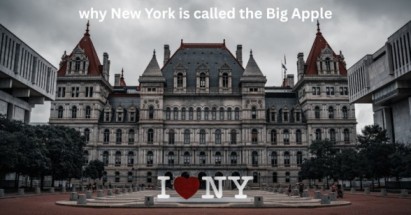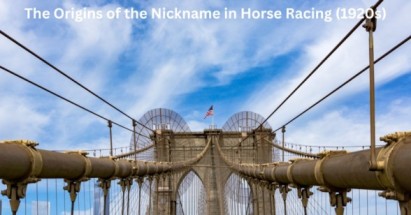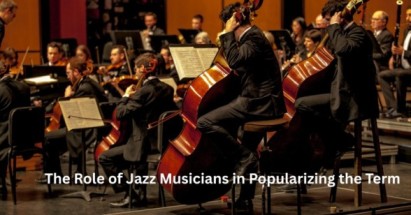Introduction
Why New York Is Called the Big Apple: When people think of New York City, one of the first things that comes to mind is its nickname—“The Big Apple.” But the question remains: Why New York Is Called the Big Apple? The story of this name is not just about a catchy phrase; it is about history, culture, jazz, tourism, and symbolism that transformed New York into one of the most famous cities in the world.

The nickname first appeared in the 1920s and has since evolved into a symbol of ambition, success, and endless opportunities. Understanding why New York is called the Big Apple requires looking back at how the phrase was created, who used it, and why it still holds so much meaning today.
This article explores seven fascinating reasons behind the origin, spread, and significance of the nickname, proving why it remains one of the most powerful city brands in the world.
1. The Origins of the Nickname in Horse Racing (1920s)
The earliest answer to why New York is called the Big Apple comes from the world of horse racing. In the 1920s, a New York Morning Telegraph sportswriter, John J. Fitz Gerald, used the phrase repeatedly in his racing columns. He explained that jockeys in New Orleans referred to the New York racecourses as “the big apple,” meaning the ultimate prize or the best track to compete on.

At that time, “apple” was slang for a city, and since New York had the most prestigious racetracks, it became “the big apple.” Riders and trainers believed that winning in New York meant reaching the highest level of success. This phrase slowly spread among racing fans and eventually became part of the city’s identity.
Therefore, the first reason why New York is called the Big Apple lies in its sports culture, where ambition, risk, and reward defined the city’s energy.
2. The Role of Jazz Musicians in Popularizing the Term
Another important piece in the puzzle of why New York is called the Big Apple comes from the jazz culture of the 1930s. Jazz musicians, especially African-American performers, adopted the phrase to describe New York as the ultimate destination for success.

For these musicians, smaller towns and clubs were “little apples,” but New York was “the big apple”—the dream stage where every artist wanted to perform. Clubs in Harlem and across Manhattan made the phrase popular in nightlife circles. The expression captured the energy, rhythm, and promise of New York, making it not just a nickname but a cultural anthem.
This jazz connection strengthened the idea of why New York is called the Big Apple, linking it forever with ambition, art, and the dream of making it big in America’s most dynamic city.
You can see this also:
- Where to Travel in North America: A Comprehensive Guide to Unforgettable Destinations 2025
- Budget Travel Tips: How to Save Money on Your Next Adventure 2025
- How to Save Money While Traveling in New York City: A Budget Traveler’s Guide 25
- How to Save Money While Traveling in New York City 2025
- Discover the Best Places to Visit in New York City 2025
- 10 Top Places to Visit in the USA: Your Ultimate Guide to Unforgettable Destinations
- The Best Honeymoon Places in the USA for an Unforgettable Romantic Getaway 2025
3. Media and Literature Reinforcing the Name
The media played a powerful role in explaining why New York is called the Big Apple. Newspapers, magazines, and books quickly adopted the phrase during the 1930s and 1940s, ensuring it reached mainstream audiences.

Writers loved the poetic charm of the term, and it became a regular feature in articles that described the glamour and challenges of New York. Travel writers used it to promote the city, while novelists and journalists kept it alive in American literature.
By embedding the nickname in popular culture, media outlets ensured that why New York is called the Big Apple was not just a passing phrase but a permanent part of the city’s story.
4. The 1970s Tourism Campaign and Branding Revival
Although the phrase was widely used earlier, it faded from everyday language by the 1960s. The true revival of why New York is called the Big Apple came in the 1970s when the city faced crime, economic struggles, and a damaged reputation.
Charles Gillett, president of the New York Convention and Visitors Bureau, launched a tourism campaign that brought the nickname back to life. Bright red apples appeared on posters, billboards, and promotional material with the slogan “I Love New York.” The campaign rebranded the city as vibrant, welcoming, and exciting.
This effort explained once again why New York is called the Big Apple—not just because of its history, but because the name became a symbol of resilience and rebirth during a difficult time.
5. Symbolism of the Apple in American Culture
To truly understand why New York is called the Big Apple, one must also look at the symbolism of the apple itself. In American culture, the apple often represents abundance, reward, and temptation. From the biblical story of Adam and Eve to the phrase “the apple of my eye,” the fruit carries deep meaning.
New York, being the largest and most influential American city, naturally fit this symbol. The city represented the biggest reward, the ultimate goal, and the most desired destination. For immigrants arriving through Ellis Island, New York was the first taste of the American dream—making the apple an even stronger metaphor.
Thus, the cultural symbolism of the apple helps explain why New York is called the Big Apple—a city that represents opportunity, growth, and ambition.
6. Global Recognition and Cultural Identity
Another factor in why New York is called the Big Apple is its worldwide recognition. Today, the nickname is used in films, TV shows, music, and advertising campaigns around the globe. Tourists buy “Big Apple” souvenirs, T-shirts, and postcards, while travel guides highlight the name as part of the city’s charm.
Hollywood films and global media helped spread the name beyond America, turning it into a universal brand for the city. Visitors often say they are going to “The Big Apple” instead of just New York, proving how deep the nickname runs in modern identity.
This global recognition cements why New York is called the Big Apple—because the world sees it as the ultimate city of dreams, culture, and endless possibilities.
7. Modern Interpretations of the Big Apple
Today, the meaning behind why New York is called the Big Apple goes beyond its history. For modern audiences, the nickname represents ambition, opportunity, and the excitement of chasing dreams. Entrepreneurs, artists, and immigrants still see New York as the place where success is possible.
The term also reflects the city’s diversity, resilience, and energy. Whether it’s Wall Street, Broadway, or Central Park, every corner of New York contributes to the image of a city that never sleeps.
This modern interpretation keeps why New York is called the Big Apple alive, showing that it is not just about history—it is about how people continue to see New York as the ultimate destination for success and inspiration.
Conclusion
So, why New York is called the Big Apple? The answer is a fascinating journey through horse racing slang, jazz culture, media reinforcement, tourism campaigns, and powerful symbolism. From the racetracks of the 1920s to the cultural stage of today, the nickname has grown into one of the strongest city brands in the world.
It is more than just a name; it is a promise of opportunity, a symbol of resilience, and a global identity. For millions of people, why New York is called the Big Apple reflects the city’s role as a place of ambition, dreams, and endless possibilities.
If you ever visit, remember you are not just in New York—you are in The Big Apple, a city that continues to inspire the world. Wikipedia








